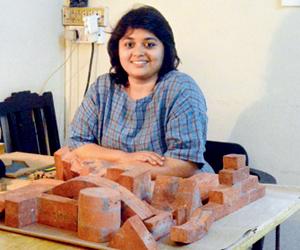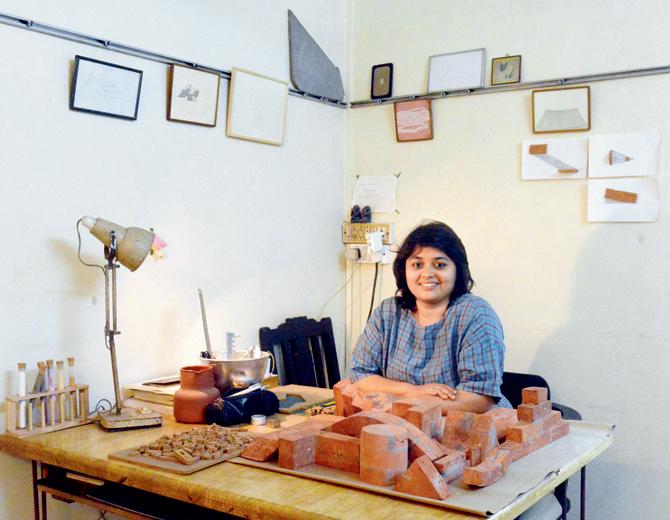Back from a show in Montreal, artist Teja Gavankar reflects on Mumbai's geometry and contradictions of urban living

 A Chakkiwala surrounded by grain-powdered hindalium containers in Lower Parel; fiery orange hues of the Fall foliage in Quebec; labourers mounted on scaffolds at a construction site in Baroda. Present any of these scenarios to Mumbai-based visual artist Teja Gavankar, 31, and she will arrive at a geometric design or an unobserved symmetry in each. She will first describe the shape of the setting monosyllabically - round, rectilinear, oval, cubic, square - before taking to richer analyses of its other physiognomies. Gavankar, a resident of Borivli, sees design schemes in everyday spaces, as is evident in her first solo, Other's Spaces, an assemblage of paper drawings, sculptures and an installation called Split Corner, which had a month-long stay before wrapping up yesterday at Montreal's Optica, a centre for contemporary art.
A Chakkiwala surrounded by grain-powdered hindalium containers in Lower Parel; fiery orange hues of the Fall foliage in Quebec; labourers mounted on scaffolds at a construction site in Baroda. Present any of these scenarios to Mumbai-based visual artist Teja Gavankar, 31, and she will arrive at a geometric design or an unobserved symmetry in each. She will first describe the shape of the setting monosyllabically - round, rectilinear, oval, cubic, square - before taking to richer analyses of its other physiognomies. Gavankar, a resident of Borivli, sees design schemes in everyday spaces, as is evident in her first solo, Other's Spaces, an assemblage of paper drawings, sculptures and an installation called Split Corner, which had a month-long stay before wrapping up yesterday at Montreal's Optica, a centre for contemporary art.
ADVERTISEMENT
Back home, and true to her not-repeat-but-reinvent dictum, Gavankar is now building on Other's Spaces for an architecture exhibition at Jaipur's Jawahar Kala Kendra scheduled for next month. She has been handed a special brief - to contribute to the conversation on spatiality through works that focus on boundaries and edges of buildings and cities, which signify social inclusions and exclusions.

Visual artist Teja Gavankar at her Borivli workspace Studioon, where she is currently repurposing bricks. Like in her earlier works, here too she is seeking newer spaces, crevices and corners within conventional brick-bound structures. Pic/FALGUNI AGRAWAL
Gavankar has often toyed with the definition of space and the lived experience it offers. "Whether in Montreal or Jaipur or Mumbai, I enjoy the idea of bringing newness to the same space by manipulating and repositioning. That I grew up in a middle-class one BHK home with five members, means I can connect with the constant struggle for space; in fact, my first response to a circumstance is usually in terms of its spatial worth," says Gavankar.
It was at the 2016 Serendipity Arts Festival in Goa that her work gathered attention. Disturbed Corner at the Young Subcontinent Exhibition received widespread attention because of its subtle probing into the notion of a secure wall corner. Gavankar's solid brick structure, protruding from different sides, underlined the contradictions in the supposedly 'safe' lifestyle choices seen in Asia. "Contradiction is at the root of urban living. We live in spaces that are freeing and restricting, secure and unsafe, green and arid, at the same time. The most frequented streets and parks can suddenly turn into targets of terror or sites of natural disasters," she explains.

Gavankar's works titled Disturbed Corner displayed at the Serendipity Arts Festival in Goa in 2016; (top) Annotated text accompanying Gavankar’s drawings on memory, 2014, Darling Foundry
Gavankar feels strongly about a city's grid plan, which is also a subject she takes up in Other's Spaces. While recognising the urban planning tool that places each street at right angle to the other, she has doubts about the effect that grids have on human imagination. "What about a deviation that can bring in the joy of an unexpected intersection?" she asks. This is a question she posed in grid-ruled Montreal too, and was able to trigger curiosity, more so because this was her third brush with Canada's art circles. Her first residency exchange was at the The Darling Foundry, a complex housing an art gallery and artist studios. This was in 2014, and she presented trace paper drawings of shapes that Montreal's horizontal landscape evoked in an Indian artist like her, travelling abroad for the first time. "I was so used to Mumbai's vertical housing colony clusters that my work started rapidly responding to a dissimilar stimulus overseas."
In her 2015 residency at Laval, Quebec, she made a platform of cubic-shaped wood, which fitted well in a green open space. "The place was so serene that for the first time, I realised how Mumbai's noise doesn't let you listen to yourself. Unbelievable as it sounds; both the residencies helped me pay attention to my own sound without background disturbances." As a young arts student pursuing a masters degree at Baroda's Maharaja Sayajirao University, and before that at Mumbai's Sir JJ School of Arts and LS Raheja School, Gavankar was hooked on gullies, chowks, parking zones, hotel lobbies, and bus stands. Whereas fellow students from mofussil India were into lush landscapes. She had never fully fathomed why she couldn't appreciate natural settings. "During my stay in Canada, I recognised that I was a confirmed Mumbaikar, instantly relating to the mathematics of space," she reveals, happy that the upcoming Jaipur assignment expects her to address the various ways in which spacemaking practices in India can be reinvented. "The idea is to create more room for improvisation within contemporary modes and methods, so that we rid ourselves of some clichés." She is part of an artist team paying collective homage to the legendary Charles Correa whose architectural world view can be traced back to Sawai Jai Singh's town planning endeavors in Jaipur.
Incidentally, Gavankar is a faculty member at the Rachna Sansad Academy of Architecture. "In Mumbai or any city whose contours are ever-changing, students and faculty of design, architecture and visual arts should play an active role. We need to align forces if we want coherent public spaces. No art can take root unless people are involved in the art practice," she urges. After every show, Gavankar shares her work with a cross-section of artists, writers, curators, researchers, and critics assembled under Hakara, a bi-lingual journal of creative expression. Gavankar is a believer in the artist's power to mould a city. "The power is dual - we build a city and then the city makes us. As citizens, whether designers or architects, we have to own public spaces, not leave their design to government-appointees."
Sumedha Raikar-Mhatre is a culture columnist in search of the sub-text. You can reach her at sumedha.raikar@gmail.com
Catch up on all the latest Mumbai, National and International news here
Download the new mid-day Android and iOS apps to get updates on all the latest and trending stories on the go
 Subscribe today by clicking the link and stay updated with the latest news!" Click here!
Subscribe today by clicking the link and stay updated with the latest news!" Click here!






